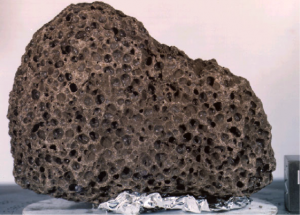Origin and significance of cosmogenic signatures in vesicles of lunar basalt 15016
D.V. Bekaert, G. Avice, B. Marty
Mars 2018. Meteoritics & Planetary Science. Vol. 53, Issue 6, 1238-1251.
doi: 10.1111/maps.13069
Cosmogenic loss, known to be significant for 3He and 21Ne, and to a lesser extent for 36 Ar (Signer et al. 1977), also occurs to a negligible extent for the heaviest noble gases Kr and Xe.
Lunar basalt 15016 (Apollo 15) – Credit: Lunar Sample Compendium, Meyer (2004)
The possible detection of a cometary signature in lunar anorthosite samples has been recently reported (Bekaert et al. 2017), but the search for an indigenous lunar (i.e., nonsolar, radiogenic, fissiogenic, or cosmogenic) noble gas component has resisted decades of investigation. Nevertheless, the presence of highly vesicular basalts on the Moon testifies to the fact that episodes of gas-rich lunar magma eruption have occurred.
In this study, we crushed basalt 15016 under vacuum and analyzed the elemental and isotopic compositions of noble gases and nitrogen contained in the vesicles but find no evidence for a contribution from a magmatic/indigenous component. Because of its large exposure duration (~ 300 Ma; Füri et al. 2017), significant amounts of cosmogenic isotopes are present in basalt 15016 minerals. By comparing the cosmogenic nuclide contents (He, Ne, Ar, Kr, and Xe) of the vesicles and minerals (derived from crushing experiments of cmsized samples and laser heating experiments on postcrushing mineral aggregates, respectively), this study brings constraints on the mechanisms of cosmogenic nuclide mobility and loss from minerals and discusses their implications for cosmogenic exposure dating.

